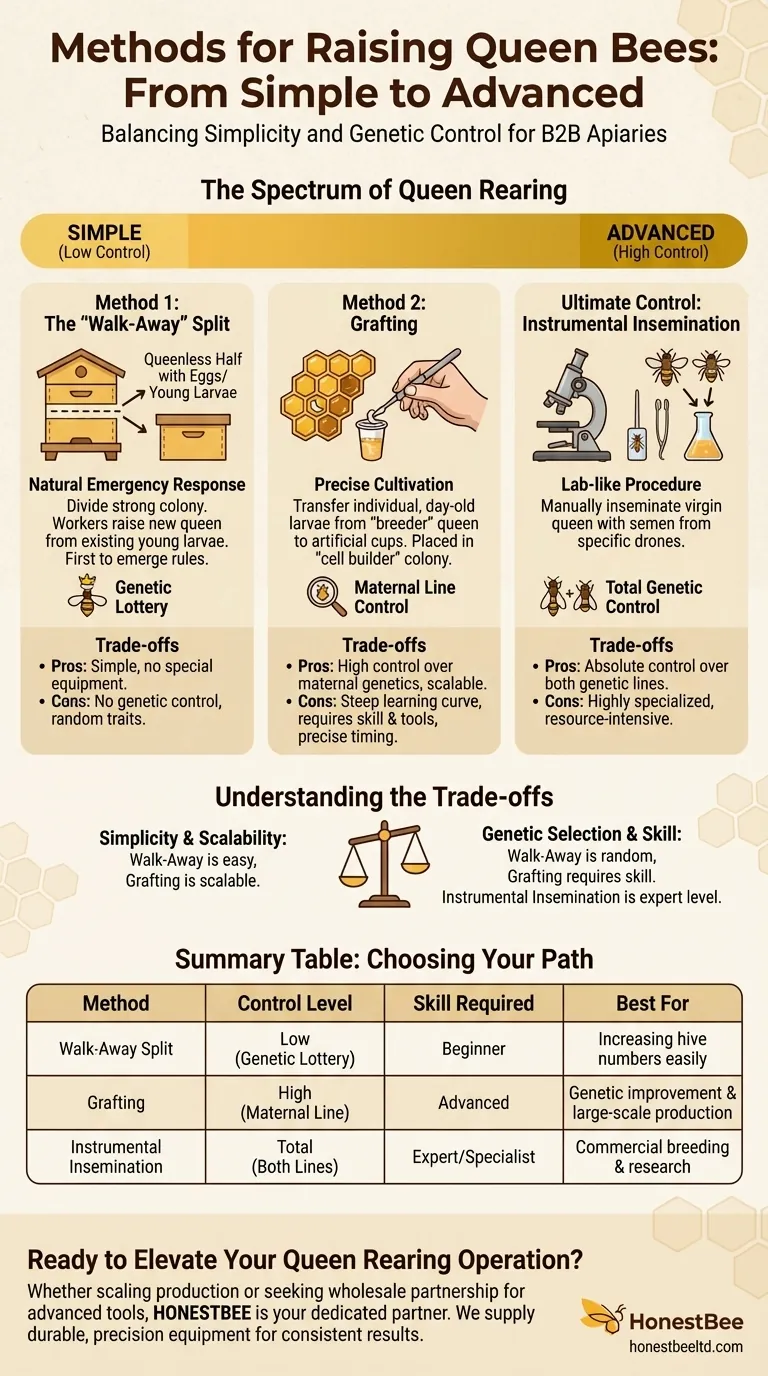The primary methods for raising queen bees fall into two main categories: those that rely on the hive's natural emergency response and those that give the beekeeper direct control over genetic selection. Simple techniques like a 'walk-away' split require minimal intervention, while more advanced methods like grafting allow for the precise cultivation of desirable traits on a larger scale.
Your choice of queen rearing method is a direct trade-off between simplicity and control. Simple methods are easy but genetically random, while advanced techniques allow for precise selection but demand significant skill and equipment.

The Spectrum of Queen Rearing: From Simple to Advanced
Understanding where each method sits on the spectrum of difficulty and control is the first step. Your goals—whether simply making more colonies or actively breeding better bees—will determine which path is right for you.
Method 1: The 'Walk-Away' Split (Low Control)
The 'walk-away' split is the simplest way to create a new queen. It leverages the bees' natural instinct to replace a lost queen.
You simply divide a strong colony into two, ensuring the new, queenless half has frames containing fresh eggs and very young larvae. The workers in this queenless colony will identify several of these larvae and begin feeding them royal jelly to develop them into new queens.
The first virgin queen to emerge will kill her rivals and, after a successful mating flight, begin laying eggs, establishing herself as the head of the new colony.
Method 2: Grafting (High Control)
Grafting is the cornerstone of serious queen rearing and is used by beekeepers who want to mass-produce queens from specific, high-quality stock.
This technique involves manually transferring individual, day-old larvae from the cells of a chosen "breeder" queen into artificial plastic or wax queen cups. This requires a steady hand, good eyesight, and a special grafting tool.
These cups are then placed in a strong, queenless "cell builder" colony, which is primed to raise a large number of queens. This method gives you complete control over the maternal genetics of your new queens.
Understanding the Trade-offs
No single method is universally "best." The right choice depends on balancing your resources, skills, and objectives. Making an informed decision requires understanding the inherent compromises of each approach.
Simplicity vs. Genetic Selection
The 'walk-away' split is accessible to any beekeeper and requires no special equipment. Its primary drawback is a complete lack of genetic control.
You are leaving it entirely to the bees to select the larva that will become the next queen. The resulting queen's traits—such as temperament, honey production, and disease resistance—are a genetic lottery.
Scalability vs. Skill Requirement
Grafting is a highly scalable method. A skilled beekeeper can graft hundreds of queens in a day, all from a single, desirable mother.
However, it has a steep learning curve. Success depends on precise timing, delicate handling of fragile larvae, and careful management of the cell builder colony.
Natural Mating vs. Instrumental Insemination
Even with a perfectly grafted queen, you only control half of the genetic equation. The virgin queen must still fly out and mate with local drones, introducing genetic variability from the drone population in your area.
For absolute control, breeders use instrumental insemination. This highly advanced, lab-like procedure involves collecting semen from specific drones and manually inseminating the virgin queen. It ensures total control over both sides of the genetic line but is typically reserved for large-scale breeding operations and researchers.
Choosing the Right Method for Your Goal
Your apiary goals should guide your decision. Instead of asking which method is best, ask which method best serves your purpose.
- If your primary focus is simply increasing your number of hives: The 'walk-away' split is a reliable and straightforward starting point that requires no new skills or equipment.
- If your primary focus is improving the genetic quality of your bees (e.g., for gentleness or honey production): Learning to graft is the essential skill for targeted genetic improvement and creating consistently better colonies.
- If your primary focus is large-scale commercial breeding or research: Instrumental insemination offers the ultimate genetic control but is a highly specialized and resource-intensive endeavor.
Mastering queen rearing empowers you to move from simply keeping bees to actively shaping the future of your apiary.
Summary Table:
| Method | Control Level | Skill Required | Best For |
|---|---|---|---|
| Walk-Away Split | Low (Genetic Lottery) | Beginner | Increasing hive numbers easily |
| Grafting | High (Maternal Line) | Advanced | Genetic improvement & large-scale production |
| Instrumental Insemination | Total (Both Lines) | Expert/Specialist | Commercial breeding & research |
Ready to Elevate Your Queen Rearing Operation?
Whether you're a commercial apiary looking to scale up production with reliable, high-quality queens or a beekeeping equipment distributor seeking a wholesale partner for advanced grafting tools and supplies, HONESTBEE is your dedicated partner. We supply the durable, precision equipment that serious beekeepers trust for consistent results.
Contact HONESTBEE today to discuss your wholesale needs and discover how our supplies can strengthen your breeding program.
Visual Guide

Related Products
- Nicot Queen Rearing Kit for Beekeeping and Grafting in Nicot System
- Jenter Queen Rearing Kit Complete Set for Bee Breeding
- No Grafting Queen Rearing Kit: System for Royal Jelly Production and Queen Rearing
- Retractable Chinese Queen Rearing Grafting Tools Equipment
- Plastic Chinese Queen Grafting Tool for Bee Queen Rearing
People Also Ask
- Can anyone use Queen Rearing with JZBZ? A Beginner-Friendly System for All Beekeepers
- What are the benefits of queen rearing for beekeepers? Gain Total Control Over Your Apiary's Genetics
- What should be done to ensure grafted larvae are well-fed? Master the Principle of Abundance for Queen Rearing
- What happens if a larva is grafted too late? Avoid Scrub Queens and Failed Rearing
- What is the Doolittle method of queen rearing? Master Controlled Queen Production for Your Apiary



















